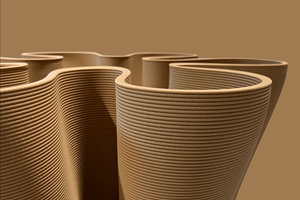CGTech to feature VERICUT Version 8 at IMTS
VERICUT V8 features a new ribbon bar allowing the user to quickly select the required function.
CGTech (Irvine, Calif.) will present its new VERICUT Version 8 at the 2016 International Machine Tool Show (IMTS) in Chicago, September 12-17 at Booth E-3346. VERICUT Version 8 will also be featured in the UK at 2016 events including the Advanced Engineering group of events at the NEC November 2-3.
VERICUT Machine simulation detects collisions and near-misses between all machine tool components such as axis slides, heads, turrets, rotary tables, spindles, tool changers, fixtures, workpieces, cutting tools and other user-defined objects. Users can also set up ‘near-miss zones’ around components to check for close calls and detect over-travel errors. Machine movements and material replacement can even be simulated while stepping or playing backwards.
VERICUT CNC machine simulation, verification and optimization software simulates all types of CNC machining, including drilling and trimming of composite parts, water jet, riveting, robots, mill/turn and parallel kinematics. The software operates independently, but can also be integrated with leading CAM systems including Dassault Systemes CATIA, Siemens PLM NX, Autodesk PowerMill and Vero EdgeCAM. VERICUT V8 features a new ribbon bar allowing the user to quickly select the required function. As you move from tab to tab, the ribbon bar updates to show the options available and options are grouped by the function they perform within VERICUT.
“VERICUT 8 is all about optimising our customers’ workflow to quickly access only the menu choices needed at the time,” says VERICUT Product Manager Gene Cranata. “The ribbon bar helps users find the functionality they need quickly and with minimal mouse clicks.”
The ribbon bar is highly customizable, but to ease the transition for existing users, a “VERICUT Classic” setting organizes all of the menus and options where users previously found them. Several other layout options are included and can be selected depending on the task at hand. Users can also create and save their own layouts as needed for different jobs.
The accuracy of the data input will directly affect the output. So an accurate model of the cutting tool and holder is required for the effective and accurate simulation of the machining process. Leading cutting tool manufacturers, such as Sandvik, Kennametal and Iscar, now make 3D solid model data available and VERICUT can read in this model data for use in the simulation process. Many of the 3D models are available via the Machining Cloud App, and version 8 has been enhanced to take advantage of more Machining Cloud metadata. This can significantly simplify the configuration of tools for use in VERICUT. VERICUT also interfaces with tool management systems such as TDM Systems, Zoller, and WinTool for access to databases storing cutting tool information. Pre-setting suppliers including Zoller and Speroni can also interface to the software, so tool offsets and exact dimensions can be applied to the simulation process.
The VERICUT logger now displays messages and reports from many sources. In addition to errors, warnings, and other messages from the VERICUT session, it also displays information from AUTO-DIFF and X-Caliper. The messages can be grouped, sorted, and displayed in a variety of ways depending on user preference.
A new “toolpath trace” feature creates a wireframe of the motion path that can then be measured. No stock model needed to generate a path. Picking on a path in the wireframe automatically sets the simulation to the current line in the NC program.
CGTech has worked with end users and machine tool manufacturers to create accurate and effective Virtual Machine Tool configurations. These range from simple 3-axis milling machines to multi-axis machining centres; simple 2-axis lathes to complex mill-turn centres with sub-spindles and robot loading; water jet and laser cutting, and machining/polishing robots.
Related Content
Composites end markets: New space (2025)
Composite materials — with their unmatched strength-to-weight ratio, durability in extreme environments and design versatility — are at the heart of innovations in satellites, propulsion systems and lunar exploration vehicles, propelling the space economy toward a $1.8 trillion future.
Read MorePlant tour: Aernnova Composites, Toledo and Illescas, Spain
RTM and ATL/AFP high-rate production sites feature this composites and engineering leader’s continued push for excellence and innovation for future airframes.
Read MoreCarbon fiber, bionic design achieve peak performance in race-ready production vehicle
Porsche worked with Action Composites to design and manufacture an innovative carbon fiber safety cage option to lightweight one of its series race vehicles, built in a one-shot compression molding process.
Read MoreSulapac introduces Sulapac Flow 1.7 to replace PLA, ABS and PP in FDM, FGF
Available as filament and granules for extrusion, new wood composite matches properties yet is compostable, eliminates microplastics and reduces carbon footprint.
Read MoreRead Next
Ceramic matrix composites: Faster, cheaper, higher temperature
New players proliferate, increasing CMC materials and manufacturing capacity, novel processes and automation to meet demand for higher part volumes and performance.
Read MoreCutting 100 pounds, certification time for the X-59 nose cone
Swift Engineering used HyperX software to remove 100 pounds from 38-foot graphite/epoxy cored nose cone for X-59 supersonic aircraft.
Read MoreUltrasonic welding for in-space manufacturing of CFRTP
Agile Ultrasonics and NASA trial robotic-compatible carbon fiber-reinforced thermoplastic ultrasonic welding technology for space structures.
Read More











